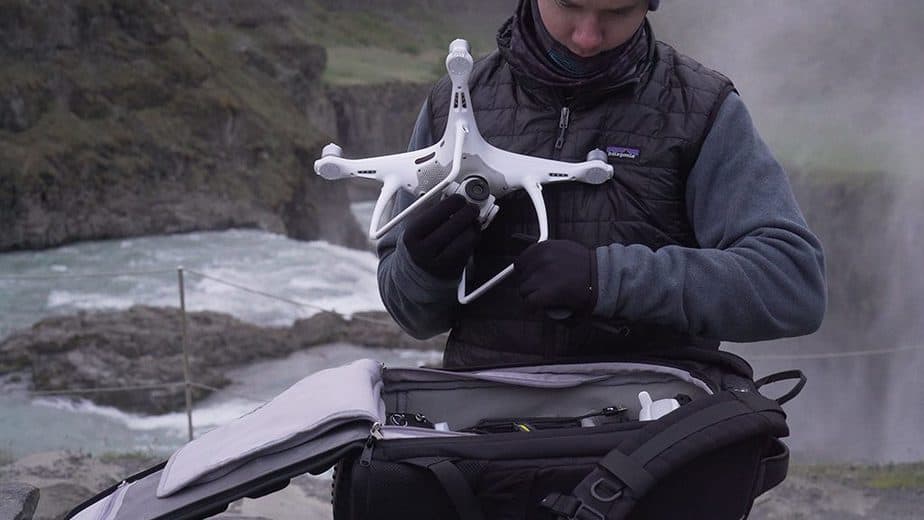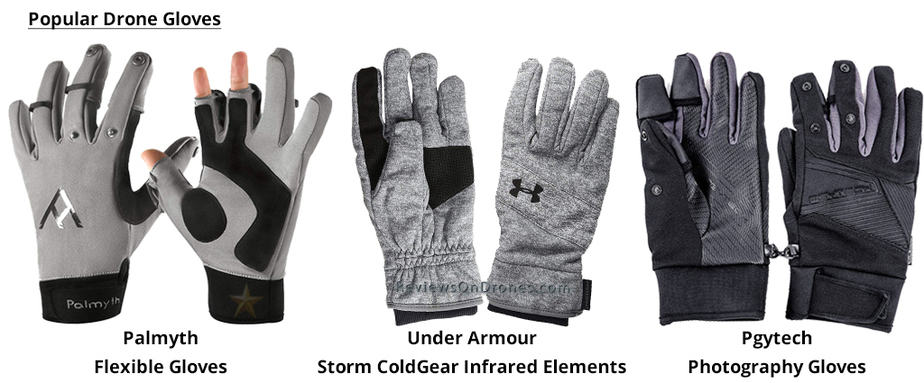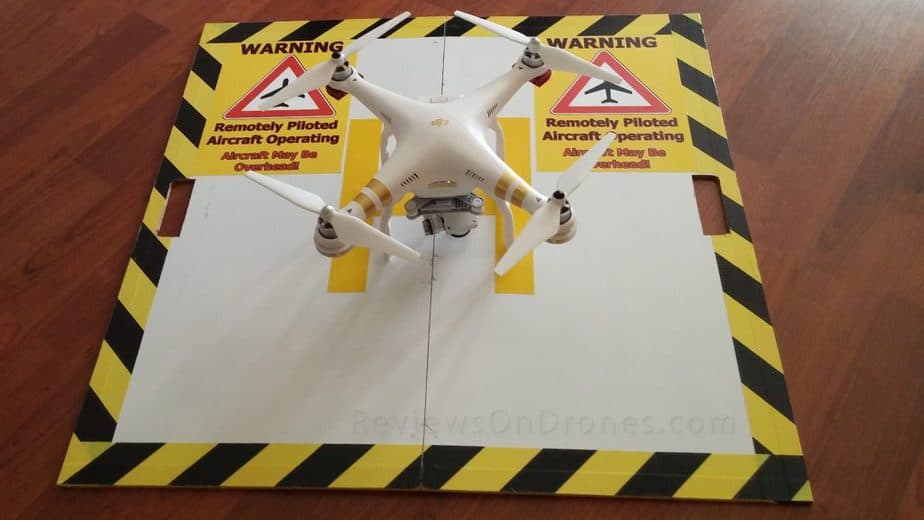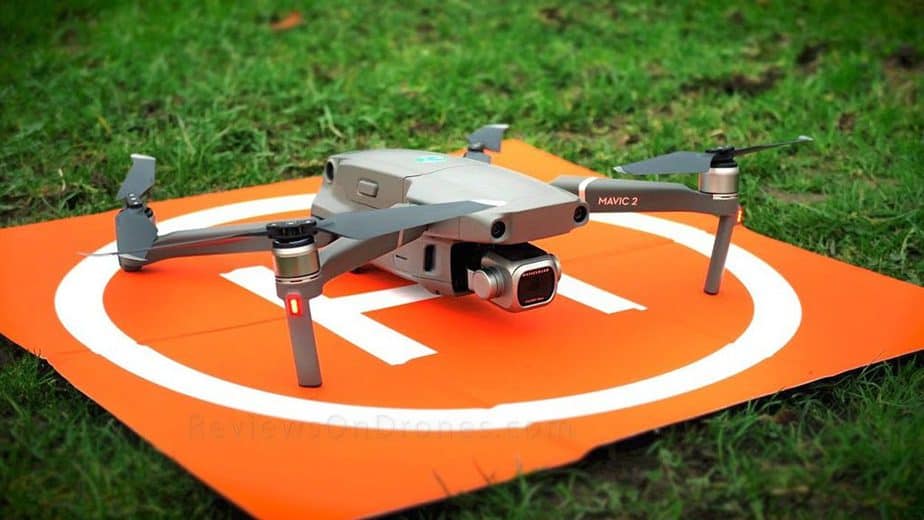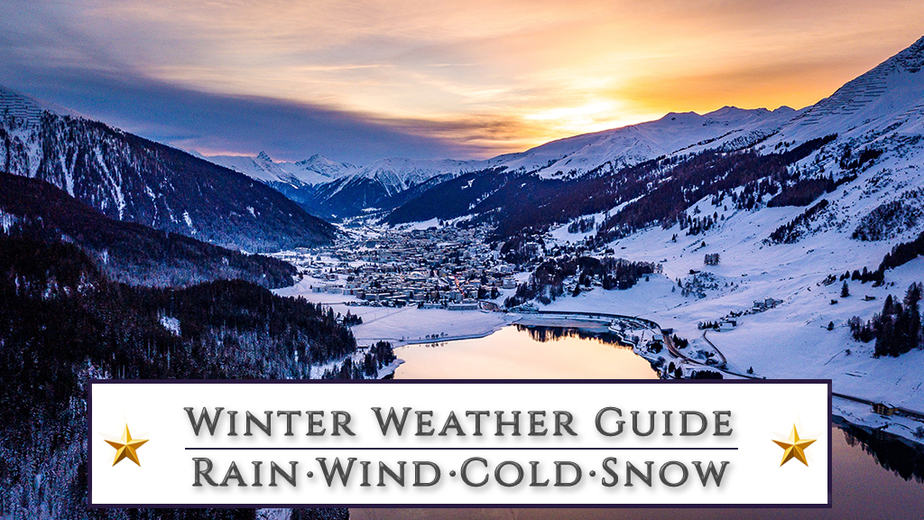
You’re about to read everything you need to know about flying a drone in winter weather conditions – including how to best prepare for winter weather flying, how winter weather impacts your drone, and a stack of useful tips to keep you and your drone right during the winter months.
Define Winter Weather Conditions
To get things started, lets first define what we mean by winter weather conditions – which of course can vary depending on where in the world you’re reading this.
For most, winter weather means snow, ice, freezing rain, high winds, long periods of cold and wind chills – and potentially sub zero temperatures, blizzards, storms and even hurricanes.
This guide addresses the most common of these winter weather conditions – those that, with the right knowledge and skill level, you should still be able to pilot your drone in, and enjoy.
Should I fly my drone in winter weather? (And is it recommended?)
So the first question to really ask is, should I fly my drone in winter weather? Afterall, the last thing a drone enthusiast wants is to be packing up their gear and putting the drone into hibernation just because the climate has changed – but sadly, that’s actually what most beginner pilots end up doing.
Why? – Well most don’t have the knowledge or knowhow to properly prepare for flying in winter weather conditions, what to expect, and of course, how to get the best from their experience. So they take the easy route and don’t try, or worse, get their drone up in the air and end up damaging it, crashing or even losing it.
But the good news is, with the right knowledge, planning and preparation, you can have just as much fun flying your drone in winter as you can in summer.
So Why Fly a Drone in the Winter?
– Is almost the same as asking, why fly a drone in the summer? – For the fun and excitement, perhaps to freestyle, race or explore, and in many cases, for the amazing photo and video opportunities.
And with photo and video in particular, there are few words to describe the incredible photos and videos you can capture. Better still, with the right planning, you can make some great comparison photos of the different seasons and how it influences the landscape, while recording video footage for a time lapse over the year is a fun long-term project too.

Hisarcık, Turkey 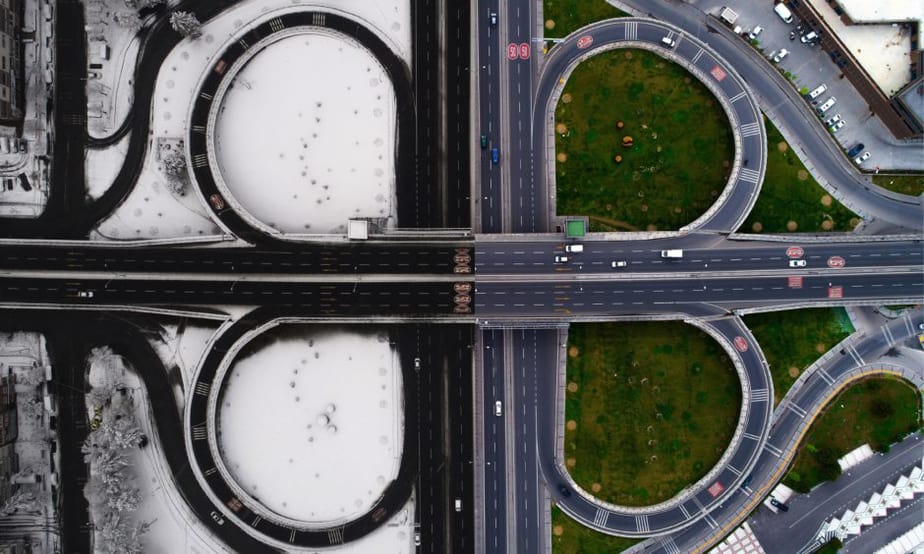
Kayseri, Turkey
There is also something very calm about flying in the winter. Despite the more extreme weather, the world almost slows down during the winter months, with fewer people and vehicles around, allowing for a more serene flying experience than most expect.
Flying a Drone in the Cold
If there is one common thread running through the different winter weather conditions, it’s colder temperatures – unless you’re lucky enough to live somewhere that is warm all year!
Challenges of Flying a Drone in the Cold
Now it’s certainly possible to fly most drones in cold weather, but you need to be aware of the challenges it presents. The first thing to remember is that the colder the weather, the higher the chance there is of ice developing on the drone.
For example, if you’re flying in 32°F (0°C) then there’s a good chance of ice developing on the propellers – which can causes extra weight to be added to the drone, reducing the flight time and potentially damage the props.
Not only that, if the ice builds up too much on the props then the entire flight can be compromised. Propellers give the drone the lift it requires to remain airborne, so if there is too much ice then the lift is reduced, making it more difficult to fly the drone.
Yet the biggest challenge of flying in cold temperatures is how it impacts the drone battery. Drones use lithium-ion batteries and unfortunately these don’t work optimally in cold temperatures, causing the battery to lose charge much quicker than normal and reducing your flight time.
If a battery offers 20-30 minutes of flight time in optimal conditions, then you can typically expect about 10-15 minutes in cold weather.
In fact, drones have recommendations for optimal flying temperatures – for most it’s 68°F (20°C). Many drones can fly in colder conditions, even below freezing in some instances, although expect the battery capacity to be lower compared to warmer days.
There are also limits that you should follow or the battery might fail mid-flight! So, to be safe, you should always check the manufacturer guidelines for the temperature range of your drone.
Most of the high-end consumer drones (such as the DJI Phantom 4 and Yuneec Typhoon) have a temperature range of 32°F to 104°F (0°C to 40°C). Some are tougher than this, such as the DJI Inspire 2 and Mavic 2, which have one of the best temperature ranges going an incredible -4°F to 104°F (-20°C to 40°C).
Flying a Drone in the Snow
Some love the snow and others hate it. Personally, I think it’s great for flying as you can take all kinds of amazing winter photography and videos – but that’s not to say that flying a drone in the snow is easy!
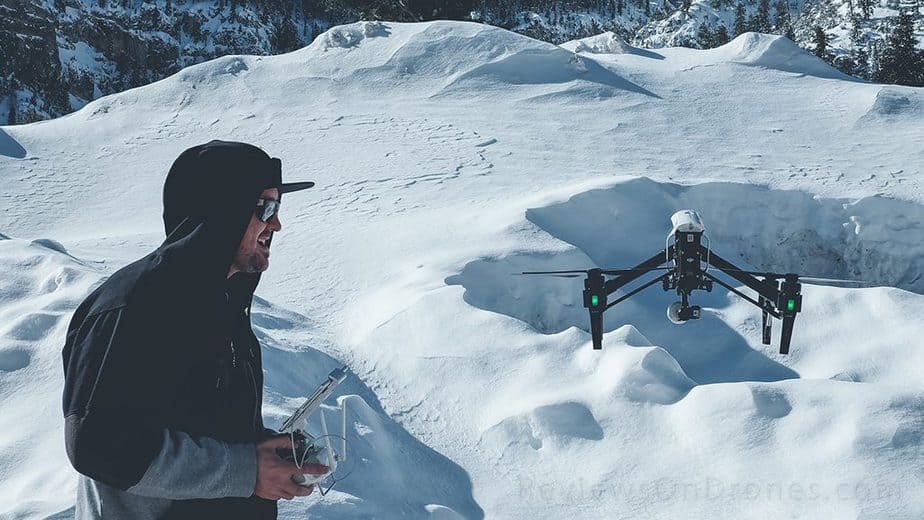
The Challenges of Flying a Drone in the Snow
At the end of the day, snow is just another type of precipitation, which is never a good thing to expose your drone to. When you think about it – water and electrical devices don’t mix well, so flying in the snow can be, and should be respected as a huge risk!
Thankfully, and this might come as a surprise to you, but snow isn’t as bad as the rain when it comes to moisture exposure. Drones can handle a bit of snow on the hull without risking any water damage, although I highly recommend that you avoid flying the drone in snowfall just to test this principle out. Instead, simply wait for it to stop snowing before flying your drone.
Of course, you can easily land in the snow, which might cause some damage depending how deep the drone lands and whether it’s tough enough to handle some exposure to snow – remembering that many of the more expensive drones have sensors on their under side (the hull).
Also, the snow can cause some confusion for the drone camera, in particular with auto focus and auto exposure, due to how bright and reflective the snow is. Plus, flying when it’s snowing can obviously cause the lens to get covered in snow, while it may add some extra weight to the drone if enough of it gathers on the hull.
Another important thing to remember is that the snow may limit visibility. By law, you must always fly your drone within a visible line of sight, so if the snowy conditions prevent this then technically you won’t be able to fly.
In most cases, I recommend flying when it’s been snowing, but avoiding flying in actual snowfall, instead waiting for the skies to clear before taking flight.
Flying a Drone in the Rain
Many countries don’t get much snow during the winter, but definitely see more than ample rain – just ask anyone from the UK! And of course rain can arrive any time of the year in most places, so it’s good to be aware of the effects rain can have on your drone and your flying experience.
A lot of people ask whether a drone can get wet or not, and the answer isn’t that straight-forward because there are so many drones on the market these days, that it’s only natural that some are more weather resistant than others.
Even then, a drone is a complex electrical device, and our best advice is to want to avoid getting it wet regardless.
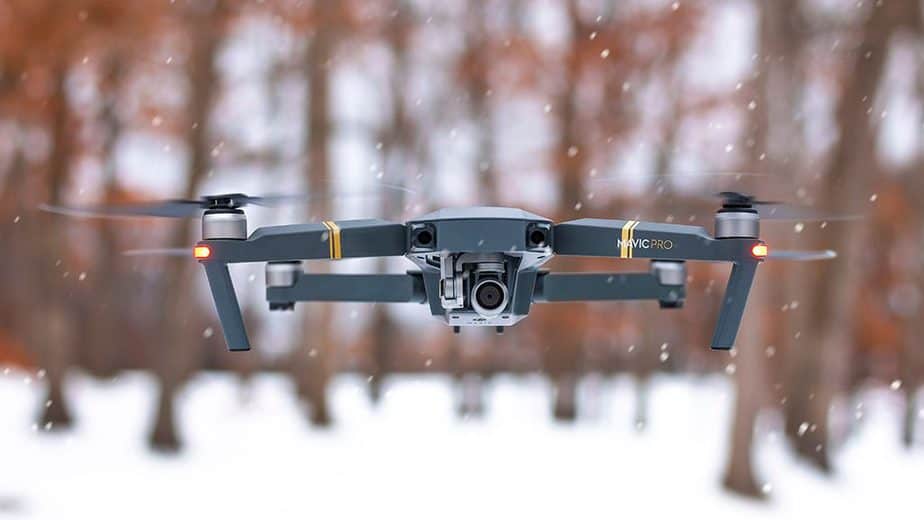
The Challenges of Flying a Drone in the Rain
The big challenge of flying in the rain is exposing the drone to moisture. When rain lands on the drone it can easily soak into the internal components and cause significant damage – and the wetter the drone, the more extensive the damage is likely to be. For example, when a lithium-ion battery gets soaking wet, you may as well throw it away, as it’s probably permanently damaged!
Rain can also cause issues with wiring, motors, and basically any of the on-board electrics, so as you can imagine, too much rain is never a good thing for your drone.
Another problem is if the rain reaches the drone receiver. And should this happen, it may cause signal interferences and make it impossible to control the drone, possibly resulting in a collision or even loss of signal.
These issues are sometimes seen from the off – moisture exposure to motor or electric board often causes the drone to short-circuit and fail even before getting off the ground. Other times the damage is subtler, with the moisture causing parts to corrode over weeks without you even noticing.
Most drones tend to have a near water-tight design to reduce the risk of moisture damage, but even this doesn’t guarantee protection. To determine whether you can fly your drone in the rain, check the manufacturer guidelines, as most will clearly state how water resistant it is (or isn’t!)
Finally, when you combine the rain with cold temperatures – a common occurrence during winter – then the moisture may end up freezing and causing extensive damage throughout the drone.
So as you can see by all the risks associated with flying in the rain, it’s generally best to avoid it. The risks certainly aren’t worth the reward, and simply waiting for it to stop raining is recommended.
And of course, if you do get caught in rain mid-flight, it’s best to return it to home, or land it as quickly as possible and dry the drone off.
Flying a Drone in Windy Weather
While not the most common winter weather element, high winds are certainly possible during the colder months and they can pose a big challenge for most when flying. Moreover, when it’s raining or snowing, it’s often accompanied by high winds, so you’re sometimes dealing with more than one problem when flying in the winter.
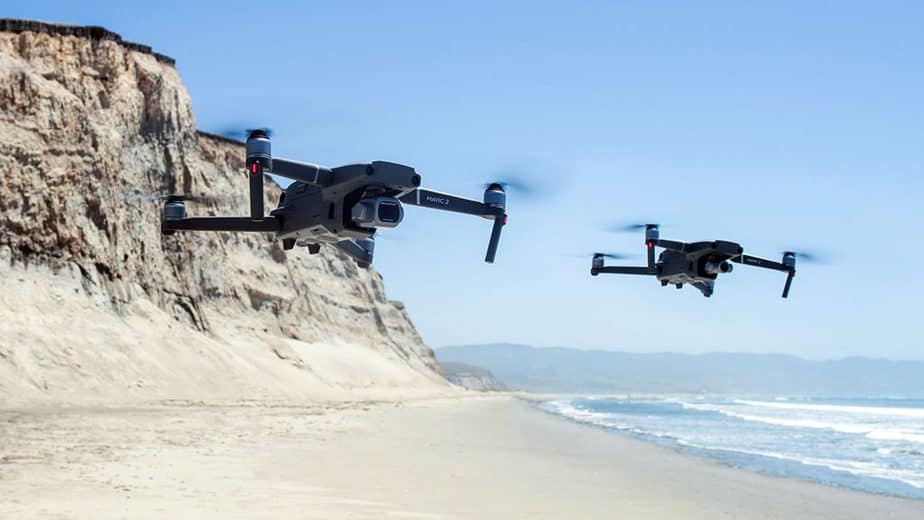
The Challenges of Flying a Drone in Windy Weather
Flying a drone on a very windy day is rarely easy – just ask even the most experienced pilots. Not only does it make the drone difficult to control, it has an impact on things like battery life, and increases the chances of you crashing into something like a tree or building.
It is certainly possible to fly a drone in high winds though – but bear in mind you will need to practice flying in these different conditions as manoeuvring the drone requires more focus and quick reactions to accommodate for the high winds.
Also, the battery will drain faster on a windy day – even more so if it is also very cold – so bring at least one spare if you intend on being out for a while, and be mindful of the lower flight time duration on each.
When you know there’s high winds outside, I always recommend flying a drone in a wide-open space and not as high up in the air where these higher winds are less predictable. Even an experienced pilot can lose control of their drone on a windy day, so if you’re flying near buildings, trees, power lines, or any large object, then there is a big chance of crashing into something.
Tips for Flying a Drone in the Winter
The simple fact is, flying in the winter is much easier, safer and more enjoyable when you’re prepared!
And so, listed below is our best tips (from experience) for flying a drone in cold and snowy weather. Sure these conditions may present challenges for a pilot, but they are easy enough to prepare for, allowing you to enjoy some winter flying without worrying about the potential to damage the drone.
Managing the Battery in Cold Weather – Warming, Charging, Transporting and Storing
Managing your batteries is one of the most important things you need to do when flying your drone during the winter.

> Always Fully Charge Batteries
The main issue that batteries face in cold weather is a performance drop that causes them to lose a good portion of their runtime. This means that the battery won’t last as long as normal, so you want to ensure they are fully charged to maximise your flight time. Having batteries fully charged to 100% is the golden rule for flying a drone in the cold winter months.
It’s not just your drone’s lithium-ion batteries that are affected by the cold – your smart phone battery will take a hit too. So be sure that your phone, tablet or mobile device is fully charged as well, especially if your drone relies on apps for flight and/or navigation.
And, as logical as this might seem, because of the lower battery capacities in cold weather, it doesn’t hurt to bring an external battery pack if you have one – and if you don’t, it’s worth the investment.
> Properly Store the Batteries During Winter
It’s important that you properly store the batteries in optimal conditions when not using the drone, and because the temperatures are much lower in winter, you may need to change where they’re stored.
Doing this ensures they remain in optimal condition between flights and reduces the issues that cold weather causes. Ideally, keeping the batteries stored close to room temperature 77°F (25°C) will keep them in top condition for winter flights.
> Keep the Batteries Warm
This is very important, but easy to overlook – keep the batteries warm on the day of your flight, for as long as possible before take-off.
As mentioned, drones have optimal operating temperatures and the cold weather is usually lower, so you’ll want to do your part to keep them warm so they remain in optimal temperature range.
By keeping the battery warm you can reduce the negative impact that the cold weather has, maximising flight time and lowering the chance of the battery dying mid-flight.
Here are some ways that you can keep a drone battery warm in winter:
Hand Warmers – A great investment for drone pilots, hand warmers can quickly heat a battery to optimal temperatures. Don’t place them directly on the battery surface though as this is too warm, instead wrap them around something (like a scarf) to keep them safe.
Wrap Them Up – Your winter woollies are great for keeping the battery warm, as you can easily wrap it in a scarf, jumper, gloves, or even a towel. Basically, anything that offers insulation from the cold is a good option!
Battery Heaters and Stickers – These devices are specifically designed to keep drone batteries warm, although you do need to check to see if they are compatible with your specific drone model.
Cooler Bag – And it’s not just pre-flight that you should be thinking about, it’s also important to keep the batteries warm when you transport the drone too. An insulated cooler bag is a great option for this is at will keep out the cold and moisture. If it’s extremely cold outside, consider adding a few bottles with warm (not boiling!) water into the bag to maintain a suitable temperature.
Keep Batteries in the Car – If you’re driving to your flying spot then it’s a good idea to keep the drone and the batteries in the car cabin rather than the trunk. It’s surprisingly cold in the trunk, so keep the batteries in the cabin to keep them warm – and remember, this would be a good time to make sure they are full charged if you have an adaptable car charger. It’s also a good idea to store spares in the car to avoid having them outside in colder temperature as well.
Self-Warming Batteries – It’s worth mentioning that many newer drone models come with self-heating battery function, although it’s usually found on high-end models such as the Inspire 2, Mavic 2 Enterprise, and Matrice 200 V2 series.
> Monitor Battery Voltage
If possible, monitor the battery voltage throughout the flight to ensure that it doesn’t discharge too much, which could result in the battery draining quicker than you anticipated.
It’s a feature found on most drone smartphone apps, such as the DJI Go app, so if you have access to this, it’s very useful for monitoring your battery in the cold and worth taking note of where to find this on screen.
For example, if a battery voltage goes below 3.2 volts, it’s likely not going to have enough charge to return to you, so always keep an eye for the voltage whenever flying in the cold or snow, as it will decrease much faster than normal.
You’ll find its easy to monitor battery voltage on your drone app, as most have it displayed in colors, with green meaning there’s plenty of charge, yellow meaning there’s not much left, and red indicating that it’s near empty and time to land as soon as possible.
So, if you forget to monitor battery voltage when flying in the winter – and your drone doesn’t have a feature that automatically returns it home when low battery is at critical levels – there is a good chance the drone will lose power mid-flight or not have enough to return to your position, so don’t take the risk and always monitor the battery voltage.
Don’t Forget to Keep Yourself Warm!
Having spent all this time focusing on keeping the drone warm it’s easy to forget about yourself. Making the effort to keep your drone warm won’t matter much if you can’t keep warm yourself, so it’s vitally important that you prepare for the cold temperatures, rain and/or snow in advance as well.
You’ll know what to expect from the winter weather where you live, so just make sure you bring your winter jacket, a good fleece or jumper, a scarf and hat, an extra pair of socks plus a good pair of winter boots if you’re walking around in the snow.
The main goal is to be comfortable enough to fly outside for an hour or so – and don’t forget that change of clothing for when you’re done!
Get a Good Pair of Gloves
Have you ever tried handling a drone controller with frozen hands? I can assure you, it’s not a pleasant experience; makes controlling the drone very challenging; and can ruin a days flying if you aren’t prepared.
While a good pair of gloves is a no brainer, I recommend investing in a pair that can be used with a touchscreen if you’re using a smartphone with your drone. Granted, many pilots don’t like the feeling of gloves when flying as it somewhat reduces your dexterity, which can be a difference maker in your flying skills that day.
It’s often a case of finding the right pair of gloves to suit your individual preferences. Personally, I like thinner flexible gloves that still offer great insulation and can be used on touchscreens. Look out for popular brands like Palmyth, Under Armour, and Pgytech.
All three are available on Amazon – the Palmyth gloves are the least expensive option and will set you back around US$20-$25 a pair – the Under Armour gloves are mid-range and cost about US$30-$35 – and the Pgytech gloves are the most expensive, coming in around the US$40-$50 price point.
Personally, I use and love the Pgytech Photography Gloves – they are also DJI’s recommended gloves for drone pilots who fly in winter weather.
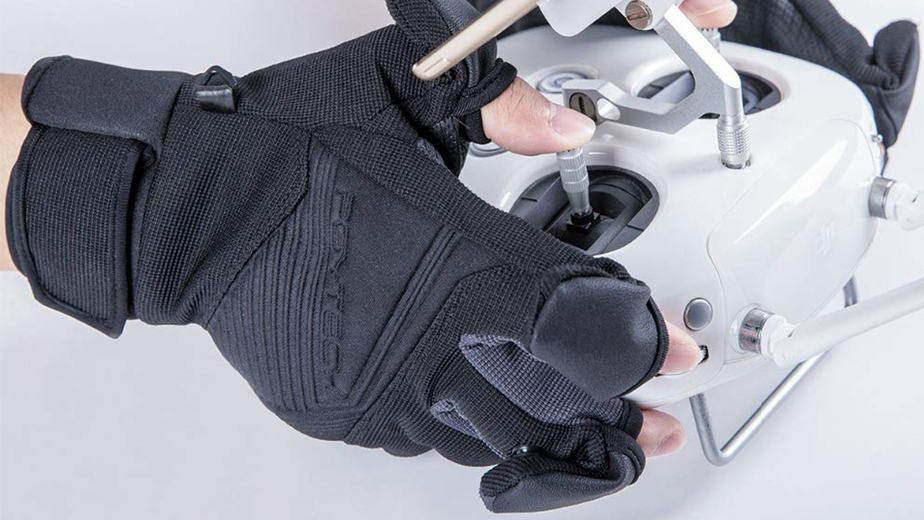
Transmitter Gloves
While not an essential purchase for winter drone flying, transmitter gloves are a great investment if you have a larger transmitter and don’t want to have limited control because you’re wearing thick pair of gloves.
It covers both your hands and the transmitter and offers great insulation from the cold. You can wear it without any gloves and keep your hands warm while controlling the drone from the transmitter.
I’m not going to lie – it looks ridiculous but you won’t care when your hands are warm and toasty when its freezing outside!
Bring a Hot Drink (and even Hot Food!)
What better way to stay warm and refreshed than with a nice hot drink? If you haven’t got one, it’s worth investing in a good quality travel flask – and even an insulated thermal food bag if you’re travelling out to somewhere that would require you to have access to snacks or a meal.
Oh and stay hydrated! This might not be something you’ll want to do when it’s cold, but it is important so be sure to have plenty of fluids on hand or nearby – even if it is coffee!
Pre-Flight Warm Up
Because its colder outside you want to give the drone a quick warm to make sure everything is in working order before taking off. It’s quite simple – just hover about 10ft in the air for about a minute.
Doing this gives the battery the chance to heat up to an optimal flying temperature! Even if you’re keeping the battery warm as previously suggested (and you really should be doing this!) the battery won’t quite be at peak operating temperature.
For instance, the battery should ideally be around 60°F to 68°F (15°C to 20°C) but it’s hard to get to this without powering the drone up. Hover the drone for 30-60 seconds and it will be at an ideal temperature and will less affected by the cold temperatures outside.
Moreover, you can see how the drone is coping in the current conditions and whether its flying as you anticipated.
Avoiding Moisture
We’ve already covered that moisture is bad for a drone. It can cause short circuiting, wires to blow, damage the camera, and increase the chances of malfunctions. So, to emphasise on the previous point – do not fly outside if its snowing or raining heavily.
A small amount of snow may not be too bad depending on how watertight your drone is, but personally I’d land before things get too extreme. The winter weather can turn in an instant, with a light drizzle quickly turning into a full-blown blizzard, so its best to not take the risk.
In terms of rain, I just say avoid flying at all costs. It’s easy for moisture to seep into the drone and cause all kinds of damage, so for me flying in the rain in winter just isn’t worth the risk.
Buy (or Make) a Drone Landing Pad
Even if its dry outside you need to be carefully where your land and take off from! Avoid the snow at all costs, as landing in the snow (or even just wet grass) can cause damage, which is why it’s worth buying a drone landing pad for your winter flying.
Drone landing pads are inexpensive and let you safely land outside in the winter weather. It’s perfect for when there is a lot of snow covering the ground, as it provides a dry landing spot to protect against moisture exposure when landing and taking off.
I continue to use the Pgytech Launch and Landing Pad because it’s an excellent product and very popular with experienced pilots… and the good news is it’s also the cheapest of the two that are worth looking at… the other being the Hoodman Pad.

Click each of these links to read more about the Pgytech Launch and Landing Pad and the Hoodman Pad on Amazon.
But remember, you don’t even need to buy a landing pad! It’s easy to make one from an old piece of cardboard or plastic, anything that will keep the drone dry on the ground.
Bring Something to Cover the Drone
Being winter, it’s likely that you’ll encounter some minor rain or snow that is likely to pass soon. Instead of packing up for the day you can simply cover your drone with a blanket or towel to keep it dry and wait it out – a perfect chance to enjoy that hot drink!
Should the drone get a little wet from rain or snow, quickly land and dry it off to ensure there is no lasting damage.
What to Do if Your Drone Gets Wet

There’s always a chance your drone is going to get wet when flying in the winter. It could be from landing in the snow, accidently flying in a snowstorm, or getting caught in some early morning fog.
This means your drone may end up getting wet when flying outside, which can be a death sentence for your UAV if you don’t act fast. The most likely way this will happen is by landing your drone in the snow.
If this occurs, be sure to quickly grab the drone and turn off the power immediately. Use a towel or blanket to dry off as much of the snow as possible.
When you get home, put the drone in a ziplock bag and leave it for a few days in a warm, sunny position. This should help evaporate any lingering moisture that is inside the drone.
If the drone gets very wet, try using adding small layer of salt (around 2-3cm) to the bottom of a black plastic bag and gently place the drone on top. Tie the bag and leave it in sunny position for a few days. The salt helps draw more moisture so it’s a good option if it gets exposes to lots of moisture.
Always Monitor Weather Conditions
Given the huge impact that winter weather has on flying a drone, it makes sense to keep a close eye on the weather conditions leading up to the day you want to fly. This gives the chance to plan everything out and ensure there are no problems caused by the weather.
Also, the weather may alter flying conditions in some unexpected ways, so it’s good to be prepared for this to avoid any accidents when you’re flying.
Winter weather brings many challenges, so I’ve outlined the different things you’ll want to monitor before you head out flying. There are lots of great weather apps that you can use to monitor these!
Air Density
One overlooked aspect of winter weather is the increased air density. Unlike the summer when the air is much thinner, the air density is much higher in winter which will have a notable effect on the drone handling.
For example, the denser air actually makes rotors much more efficient, meaning the speed of the drone will be much quicker than normal. It may feel like you’re in sport mode when you are just flying in standard mode, so be prepared and adjust your controls according.
This isn’t really a bad thing in my view! The denser air offers great stability, which is ideal for capturing videos and particularly long-exposure photographs. Those cold days may offer some of the best conditions for aerial photograph!
Temperatures
You can fly in colder temperatures during the winter but there are some temperatures where it’s better to just avoid flying that day. For example, if the weather outside reaches 32°F (0°C) or below, don’t bother flying as it’s just too cold.
This is because the colder it gets the less efficient the batteries become, so when its too cold your flight times become really short that its rarely worth the effort. Sometimes it’s just too cold!
Precipitation
I feel I cannot hammer this home enough – don’t fly when it’s physically raining or snowing!
Yes sure, you can maybe get away with light precipitation, but in my view the risk is never worth the reward. Wait for it to dry up, or better still, for a dry day when there is no concern about potentially damaging a very expensive drone.
Visibility
There may be a winters day that is seemingly perfect for flying your drone. Not too cold, no rain or snowfall, and the ideal air density for flying. However, there is one part of the weather that we can often-overlook as drone pilots – visibility.
Both fog and low cloud banks are common throughout winter and these bring low visibility. Remember, by law you always need to keep your drone in a visible line of sight, yet low visibility can make this very difficult or even impossible.
Moreover, if the visibility is poor you may struggle to properly navigate the drone. This means more chances of crashing or even losing the drone entirely, so always be sure to check the weather forecast for visibility.
Plus, flying in fog or close to clouds can expose the drone to moisture, so make sure to avoid this at all costs!
Limit Speed, Throttle, and Flight Duration
The entire goal of this guide is to highlight how it’s not just possible to fly a drone in the winter – it’s also great fun!
However, it is important to adjust how you fly and how long you fly for in the winter. Yes, you can fly a drone in the winter but if you aren’t flying it correctly then it’s not a fun experience at all. Winter weather brings some challenges so you need to be prepared for this!
There are three key aspects of flying that you should adjust to accommodate.
Firstly, you’ll want to limit both the speed and throttle when flying the drone. Remember when I said that dense air meant better flying conditions? This can also make the drone controls much more sensitive, meaning you get more speed and throttle from controller inputs than normal.
Just be more senstive with your controls than usual. Don’t push down too hard on the speed or throttle, as the drone may take of much faster than you expect. This is why it’s a good idea to get a quick feel for the controls when hovering the drone to warm the battery!
Taking it easy on the controls will also help conserve battery life, which is already limited in wintery conditions, so try being gentle when flying in the winter weather.
Also, the battery is going to last less than normal. Even when you’re keeping the battery warm before flying the outside temperature will reduce the capacity as you fly, so reduce your normal flight times to compensate for the lower battery.
A general rule of thumb is the lower the temperature the less flight time you have – this is why you want to monitor the outside temperature to make sure you are prepared!
Adjust Camera Settings for Winter Weather
One of my favorite things about flying a drone in the winter is taking photos. Flying high into the sky to capture aerial shots of the wintery landscape is so much fun and definitely something I recommend for photography enthusiasts.
That said, when it comes to taking photos with your drone in the winter there are some adjustments that you’ll want to make to ensure they look good. While the snow-capped landscapes offer amazing photo opportunities, it also creates a highly reflective surface that isn’t always easy to photograph.
When photographing lots of snow, your drone camera is sometimes confused by the bright, reflective surface, causing it to automatically adjust the exposure settings to compensate.
The camera thinks there is too much exposure so will lower the settings, which results in under-exposed photos – the snow looks dull and greyish rather than a brilliant white.
Additionally, the white balance can sometimes be off if left on automatic, causing the snow to take on bluish color that can ruin the photograph. Note – this only effects photos shot in JPEG.
The good news is that these settings are easy to adjust – both the white balance and auto-exposure can be adjusted from your drone camera settings.
Turn auto exposure to a manual setting. Because the camera is adjusting for over-exposure, the trick is to increase the exposure setting to compensate, otherwise the photos come out under-exposed. A slight adjustment of a stop or two should be fine – take a photo with a few different adjustments to see what looks best.
The approach works for white balance settings. Simply make minor adjustments and take a photo to see what works well. Remember, its likely to come out bluish on auto settings, so make some small changes to get the whiteness you’re looking for.
Another quick trick is to slow down the shutter speed. The quicker the shutter speed the more under-exposed the image becomes, resulting in a greyish looking snow, so slowing it down a bit should make it look whiter.
Consider Buying an ND Filter
If you’re not confident of adjusting your camera settings then a quick fix is to buy a neutral density (ND) filter. Simply attach an ND filter to the camera lens and all the issues photographing winter and snowy landscapes become a thing of the past.
ND filters reduce the amount of light that pass through the lens. This is perfect for taking photos in the snow as the landscape is brighter and more reflective, causing more light to pass through the lens. Just attach the ND filter and you can take some beautiful winter photos without any hassle.
There are many brands of ND filters available for you to choose from, and you can see some of the most popular options selling on Amazon here.
We use what most experienced drone pilots would say are the market leaders, and that’s a brand called PolarPro. You can check out their range here.
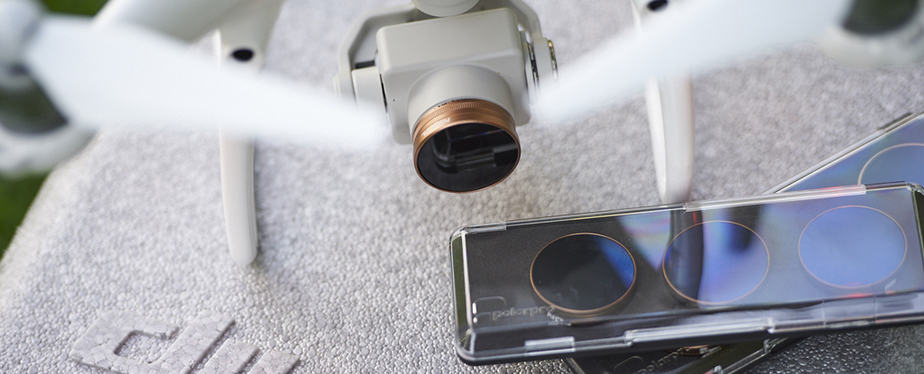
Keep the Lens Clear
If you are flying your drone in light rain or snow, a great tip is to actually fly backwards, as this helps keep the elements out of the lens and from ruining your photos. This may require a bit of practice to get the hang of though, so if you’re struggling to fly in these types of conditions just make a quick landing and wait for them to pass.
Plan Your Entire Flight
Flying a drone in winter is full of new and unexpected risks. It could be a battery dying unexpectedly, flying faster than you planned and crashing into a tree, or flying above a body of water that you didn’t even know was there.
This is why you always should plan your trip when flying a drone in winter!
Start with a rough idea of what you want to achieve – for most it is taking some cool photos, so maybe try work out what types of photos you want to take.
Is there a certain landmark where you live that would look cool covered in snow? Do you want to take time lapse photos of the same area throughout the year? Are you playing it by ear and seeing what captures your interest when flying?
It’s always good to have a rough plan of where you’re flying, as you can prepare properly for the environment and bring the necessary supplies. My one piece of advice when planning where to fly a drone in winter is to avoid bodies of water at all costs!
Once you plan out where you are going to fly, you can plan the rest of the trip using all the tips and tricks we’ve covered here. Better still, make a pre-flight checklist of all the stuff you want to take, what needs charged, camera settings, how long you’ll be flying for etc.
Time is limited when taking your drone out for a winter flying session – a good plan lets you make the most of the time you have!
Conclusion
It’s not only possible to fly a drone in the winter – it’s so much fun that I cannot recommend it enough. Once you’re aware of the challenges that certain winter conditions provide, it’s easy enough to prepare for them to ensure you have a fun time flying.
Batteries are probably the most important thing to remember. Always make sure they’re charged, have a few spares, and be ready for a shorter flight time when it’s cold. Beyond this, you’re mainly adjusting your camera settings and remembering to keep yourself warm too! Remember to play around with different camera settings and that the drone will handle slightly differently compared to warm days. You’ll get the hang of most of this by going out and flying yourself but it helps to have some pointers that will let you best prepare for flying your drone in the winter!

